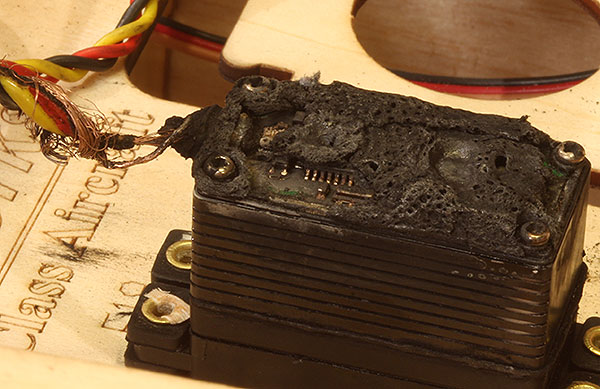



This is the result of me not taking advantage of the current limiting setting in my
servos that prevents overloading, as I was doing.
Text and photos by Tom Hintz
Posted 12-14-2015
I came close to losing my Aeroworks 50cc Edge 540 in flight yesterday. I didn’t almost have a mid-air collision and I didn’t almost fly it into the ground either. It might have been a three-year-old, heavily used servo simply giving up in a cloud of smoke but I doubt that. Modern digital servos are complex electro mechanical devices and it is unreasonable to think none of the millions sold would fail but I don’t think that is what happened in this situation. I think it only fair that my Aeroworks 50cc Edge 540 take some of the blame for flying knife edge so well that it lured me to the dark side. The most likely suspect is of course me and on two counts.
I had been flying knife edge continuously for a few minutes practicing my knife edge figure 8’s and ovals. Then on a pass down the length of the field, still knife edge the rudder neutralized and the Aeroworks 50cc Edge 540 nosed over towards the ground. I rolled out of that and began a turn in towards the runway to do a fly-by so I could “shake” the rudder to see if it responded either way. I was thinking that one of the pull-pull cables had failed. Not true. When I started the turn it was obvious that the rudder was not responding when I tried to nudge the tail around to shorten the turn. Then on the ground I had no steering in either direction so I hit the engine kill and thought the incident was over.
When I put the Aeroworks 50cc Edge 540 on the stand to start tearing it down to find the problem I smelled smoke. Then I noticed the inside of the canopy getting “cloudy”. With the screws out I lifted the canopy off and a little but scary cloud of smoke came out of the fuselage along with the unmistakable odor of an electrical fire. Though I had shut down the electrical power on the field before pulling the Aeroworks 50cc Edge 540 back up the length of the runway the wires from the rudder servo were still smoking as was the rudder servo itself. Not liking the possibilities of that kind of heat a few inches from the remaining 12 ounces or so of gasoline in the tank I removed the rudder servo as quickly as I could.
When I laid the servo on the table we saw the full extent of the damage for the first time. The HiTec HS-7954SH was a gonner, some of it literally. The bottom cover had been reduced to something approximating charcoal and the servo lead was nearly burned off entirely. The area surrounding the servo in the plane was also charred, there were pieces of charcoal-like debris in the bottom of the fuselage and some of the other wires in the bundle with the rudder servo were scorched. My Aeroworks 50cc Edge 540 had nearly caught fire in the air.
While putting the blame on the servo itself would make me look lucky I have to abide by my “warts and all” policy on FlyingRC.net. Being honest about my screw-ups benefits my viewers. All of that continuous knife edge flight with the very large, very effective rudder deflected put a bunch of stress on the servo. That builds temperature that would have dissipated some if I had relaxed the rudder now and then but I didn’t.
Like many HiTec programmable servos the HiTec HS-7954SH has a feature called OLP or Over Load Protection and I had not used it. This feature reduces the electrical power applied within the servo when it encounters an overload situation, like me holding a bunch of rudder to sustain knife edge flight for an inordinate amount of time. To make matters worse I have and frequently use the HiTec HFP-25 Digital Servo Programmer & Tester needed to enable the OLP system in the servo. I simply did not enable it and have no legitimate reason for not using it. Simply put, my bad. Worse is the knowledge that I very nearly set my Aeroworks 50cc Edge 540 on fire in the air because I didn’t use the OLP system.

If I would have used the built-in capabilities
in my servos, this would not have happened.
While I am going through the Aeroworks 50cc Edge 540 to be sure I have found and repaired all of the damage I will also be programming all of the servos to use the OLP feature and having it reduce power by 50% or so when it senses an overload.
The other major part of my strategy to prevent a similar failure is to use my head more and break up high-servo-stress situations like prolonged knife edge flight. It shouldn’t be surprising to you or me that common sense piloting can prevent crashes and damage to our planes that could cause a crash. In my case here an on board fire could easily have led to a burning airframe crashing.
The final piece of my new plan is this story. I hope that owning up to this bit of stupid airplane setup on my part will help prevent you from doing something similar. I think that a web site should work at presenting useful information and in this case that information can literally save you thousands of Aero modeling dollars. Remember it. Use it.
Have a comment on this story? –Email Me!